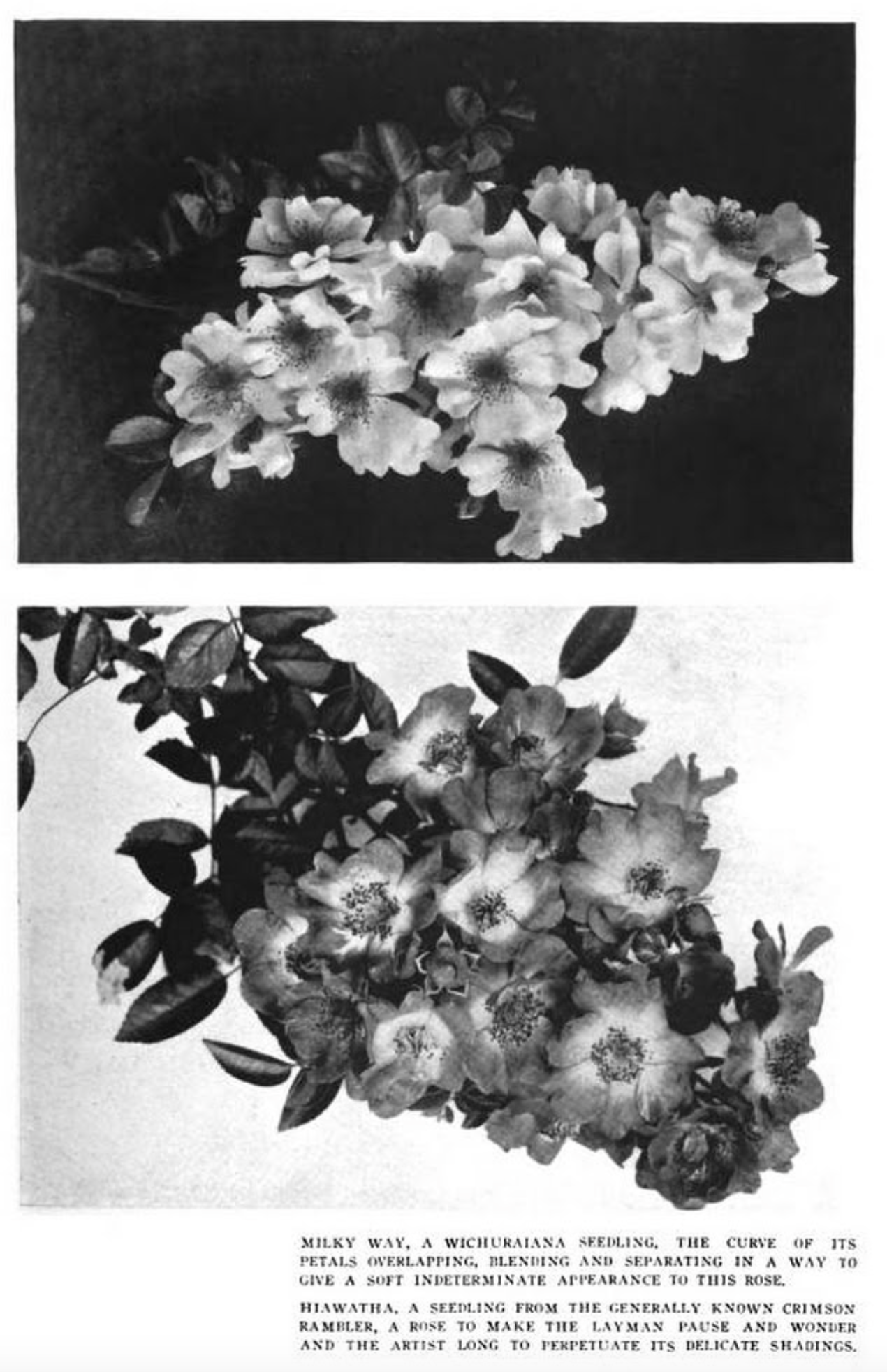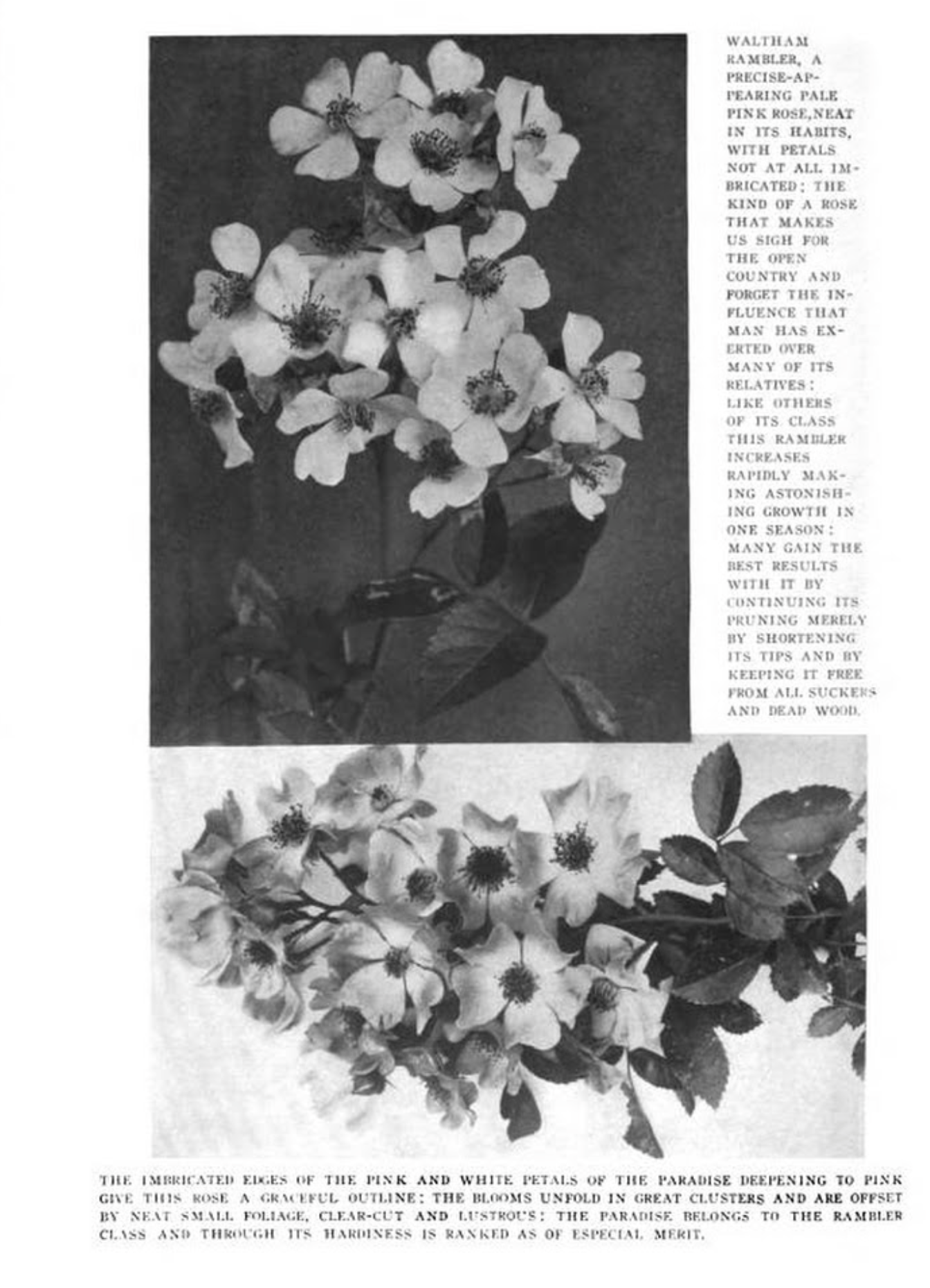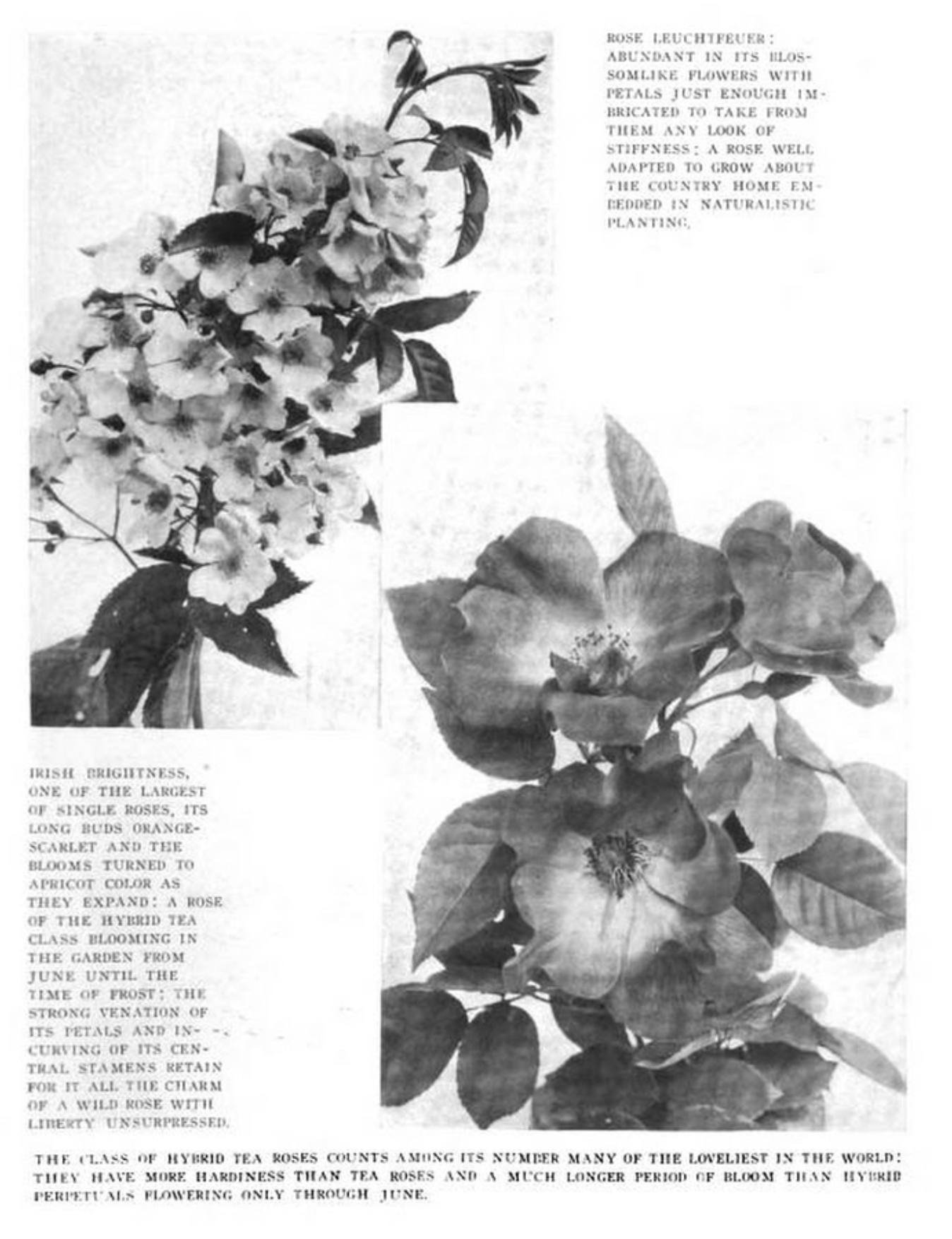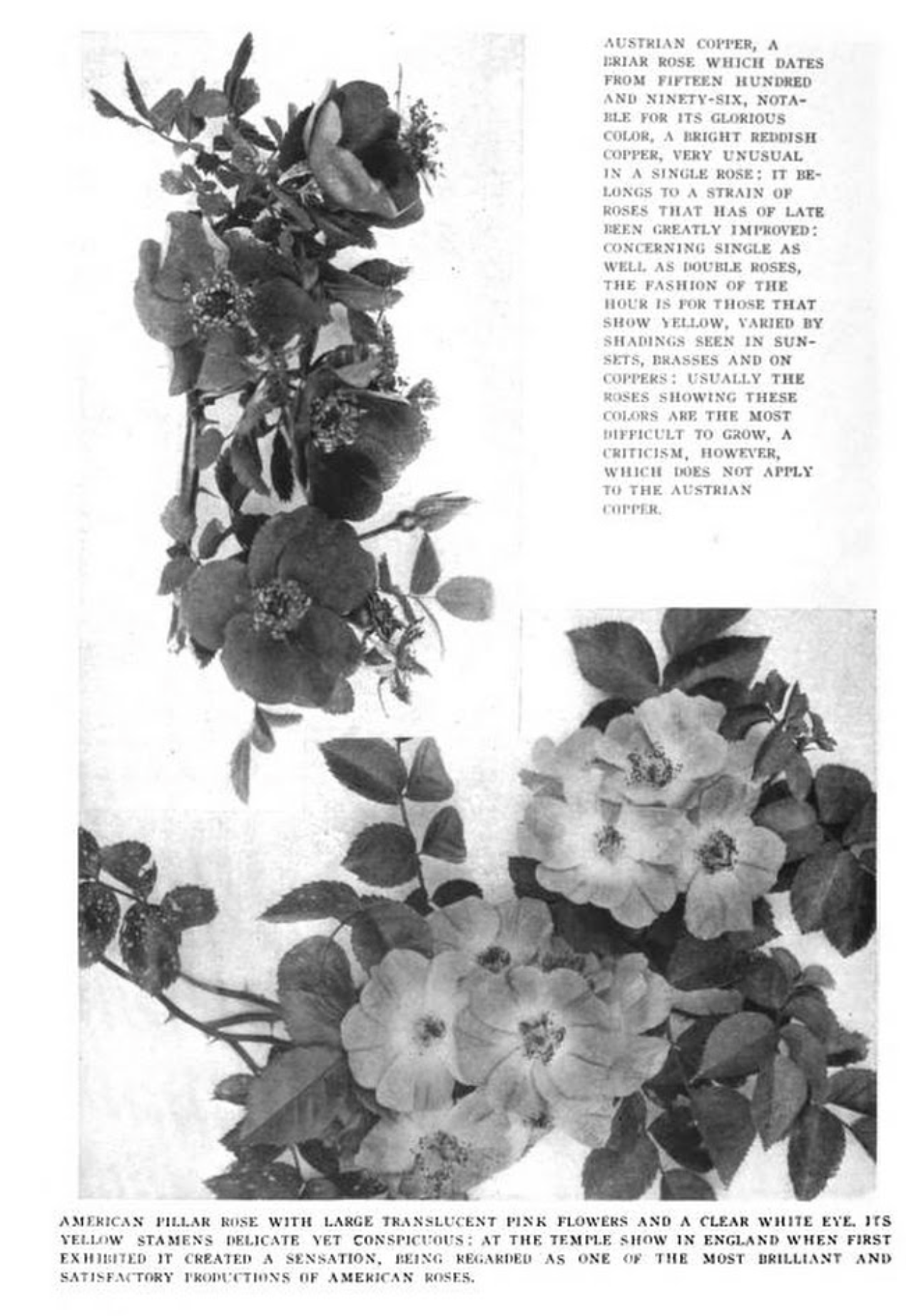|
“Untamed, untamable, The rose is as old as history. It is loved alike by prince and pauper. To criticize its fairness is merely another form of decrying the spots on the sun. But the garden rose of today is no longer that of yesterday. It is smitten with the idea of progress: it moves with the times, welcomes advancement, lends itself to many and various human efforts, cleverly conceived for its betterment. In consequence the rose lovers of America have for their beguilement some altogether new strains of these flowers, many of which are particularly well adapted to informal home gardens, the cozy little gardens snug and peaceful. Within the last few years the single rose, the rose of few petals and many stamens, has regained to a certain extent the place usurped by the rose of multitudinous petals. For, centuries ago when men began to exercise their power over the rose, it was forced to lose the stamens that made its center look like a mine of gold. The wild rose of the open country used its stamen and pistil naturally, after the manner of other blossoms, to reproduce and to perpetuate its race. But specialists in rose culture soon devised a way of continuing roses through cuttings, thus taking into their own hands the full responsibility of perpetuating, enlarging and improving a species. The rose was deprived of its reasonable work, perhaps as well its joy. The central stamens and pistil, giving to the single rose the impression of a heart of gold, suddenly found themselves without an occupation. Their usefulness became a thing of the past. And gradually they began to disappear or rather to be transformed into petals, the purpose of which in any flower is to give protection to the central organs of life and to attract insects which assist them in the matter of cross-fertilization. In fact, as the stamens and pistil of the wild rose were transformed into petals its depth and size increased until its lovers beheld it a double rose, a rose of multitudinous, incurving petals wherefrom the type of the simple wilding seemed far removed. In this matter of the transformation of stamens into petals, the well-known water-lily is an interesting example, although, in this particular case, it may be that its petals vice-versa are trying to become stamens, the point being one on which scientists disagree. In either case the evolution is taking place under the supervision of Nature, who unlike an expert gardener acknowledges no necessity of haste, evolution being with her a matter if a million or so of years. Perhaps the water-lily originally occurred as a single flower with a sufficient number of stamens and pistils to produce seed for its reproduction; and then on finding out that it could do this work by means of roots, began to transform its central organs into petals. Or it may be, as is held equally strongly by many of its students, that the aim of the water-lily is now directed toward reproduction by seed; and that to this end it is changing from its original type and endeavoring to reduce its many petals to seed-bearing organs. To look into the center of the flower is to see plainly that either in one way or the other the change from petals to stamens is slowly taking place. With roses, however, no such plain illustration of this process is to be observed, because the work has been done artificially by men feeling that they had not a minute to lose and who have employed every artifice and craft likely to serve their will. One day the rose was a natural wilding living a simple life, fertilized by insects, bearing seed and casting it forth on the fair earth; the next it was a luxurious creation without power to reproduce itself, depending for its existence entirely upon the constancy and skill of man. The double rose can only be ranked as a hybrid among hybrids, beautiful, glorious if one will, free from all care. Over the world today it is seen in a state bordering perfection, showing a sculpturesque beauty, amazing even to those who have devoted their lives to bringing about its so-called perfection. The double rose is no longer merely a rose; it is an achievement, vying with other stupendous works of the age. But trickling like a silver stream through the universal admiration for the perfected rose, is the cry of faithful lovers for the single specimen showing no special evolution but just a wild sweetness and the meaning piquancy of yellow stamens: a cry for a rose that appears to follow the laws and restrictions of Nature, unchanged by excesses. There are still in the world simple souls, the number of which is happily swelling, who love flowers pure and sweet, not particularly amazing in size or color. It may be that Americans are in the early stages of simmering down to an appreciation of simple things such as is acknowledged by the Japanese. From the lives of these people of the Land of the Rising Sun so much has been eliminated that they abide very near to the inwardness of things. They care not for strong or brilliant colors; they prefer flowers with merely a few petals, delicate and evanescent. For them peach blossoms have exquisite meaning, while the American Beauty rose portrays to their mind a barbaric achievement. That American rose gardens are planted for mass and color effect is incomprehensible to a Japanese, caring for the individuality of each bush and drawing inspiration from the angle of each twig and leaf. He looks not only at the flowers of his garden, for him the plant as a whole has a more thrilling message. Still it is unlikely that the people of this newer, more exuberant country would have declared so loudly their present admiration for single roses had it not been for the propagation of hybrid seedlings taken from the wichuraiana and rugosa stock, both Japanese single roses to which can be traced today the new race of ramblers and climbers, inestimable in their value for outdoor decoration. These new strains of roses are more lovely in the single varieties than in the double, although such a statement must always be tempered by individual preference. Some of the new roses are semi-double, like the wonderful Milky Way that has made so great a sensation both at home and abroad. Its blossoms, however, are not sufficiently double to hide the central crown of exquisite yellow stamens giving abundant character, showing determined purpose. In this rose is clearly to be traced a likeness to the Japanese parent, Rosa wichuraiana, even though its beauty far surpasses the original. Still the simple brilliancy of the quaint wichuraiana is in Milky Way glorified. Its foliage is equally fine and its hardiness even greater than that of the stock from which it has sprung. Hiawatha is a remarkable single rose, glowing in ruby-crimson, having a clear white eye. It is a seedling from the crimson rambler, an introduction from Japan that has taken with avidity to the soil and climate of the New World, growing here at present like a weed. Of all the single red rose climbers, Hiawatha is perhaps the best known. It was produced by an American grower who won through its aid international acclaim, it being a rose which fits into many moods of the rose lover. About it there is a magnetism, a brilliancy and an absence of stiltedness appealing with undeniable force to the sponsors of single roses. Beside a double climbing rose or a semi-double it appears to the better advantage, while as far as hardiness is concerned it may be described as iron-clad. This characteristic hardiness held by the climbing rambler roses is perhaps their greatest asset since it places them within the reach of all; expert gardeners, glass houses and pampering to any extent being adverse to their natures. Through the use of such roses effects can be obtained in simple home gardens that would have been impossible a dozen years ago in any but those of subtropical climates. In fact, it is owing to the hybrid rose climbers that the gardens of the North, the West and the East where the thermometer drops low in winter and gales are high and searching, are able to show the luxuriance of bloom, pluri-color and fragrance and to exhale a similar spontaneity to that of the South. Moreover, these strains of roses are unrivaled to grow on trellises, pergolas, gateways and arches, and to train in pyramidal or other forms as specimen plants, useful on the lawn, the veranda, as well as in gardens at points requiring accentuation. Little more care need be given them than that extended to ordinary vegetables. They crave but the opportunity to grow intensely. In planting roses, no matter of what description, it is only justice to them to choose for their habitation spots where the passage of air is untrammeled, not those, however, of a wild besetting wind; spots where they can be visited by both sun and shade. The most vigorous rose plants are found in gardens sun-ridden in the morning and dimmed by shade in the afternoon. They like to be by themselves. In their temperaments they are exclusive. Rose plants, therefore, should not be set near the base of trees or in beds where shrubs, perennials or annuals are numerous and able to draw from the soil its nourishment. For roses, be it said in all kindness, are the greediest feeders of any plants. They must have food in full and plenty if they are to send out their blooms freely. It is because many who regard themselves as rose lovers are oblivious to the absorbing appetites of their garden wards that their efforts are not more successful. In climates of severe winter weather rose-bushes should be covered about their base, in the late autumn, somewhat heavily with manure, which should then be dug into the ground, not disturbing their roots, as soon as the spring is well established. From time to time they should be fed bone meal or some other fertilizer able to keep the soil about them well supplied with nourishment. Soot, put aside when chimneys are cleaned, is one of the best fertilizers especially for tea and hybrid tea roses. Liquid manure is used by many growers to increase the size of blooms, a practice used more in connection with show roses than with those purely for decorative effect about the home. Pamphlets, articles, even books have been written to put forth arguments and suggestions about the best way to treat insects that delight in destroying rose-bushes. Insecticides, deadly as the poison of Romeo, are on the market to slay these miserable creatures by the thousands. Fear, abject fear of the insect world and its unscrupulous ways has kept many sensible human beings from attempting to grow the queen of flowers, but this fear would melt away if the simple rules were followed of giving the bushes a free circulation of air, protection from high winds, plenty of enriching food about their base, and sunshine for at least part of the day. Vigor tends to make the bushes immune from insects—perverted creatures caring only for tainted, diseased sap. Another trial to the amateur rose grower is pruning; it is true that the different kinds of bushes require different treatment. The single rose, occurring as a hardy hybrid perpetual, should be cut back each spring about two-thirds of its last season’s growth; the pruning go a tea rose should be much less severe, while the climbing and rambler roses often need only to have their tips shortened, and to be kept free from all suckers and dead wood. But the true rose lover has an instinct about pruning, a subtle inspiration telling him when to clip and when to stay his hand. For those who hear not this whispering of the inner voice it is always a possible, even a simple thing, to consult a local florist or nurseryman and to get from him the necessary information about sensible pruning. The great rose growers of the country, those who have bred the new single roses and others, are invariably glad to send out from their nurseries instructions as to the right methods of pruning their offspring. And when the supposed difficulties of pruning the rose, of slaying its insect devourers and of feeding it with food sufficiently rich, have melted away, what is there left to do but to love it,—to love it profoundly. |



